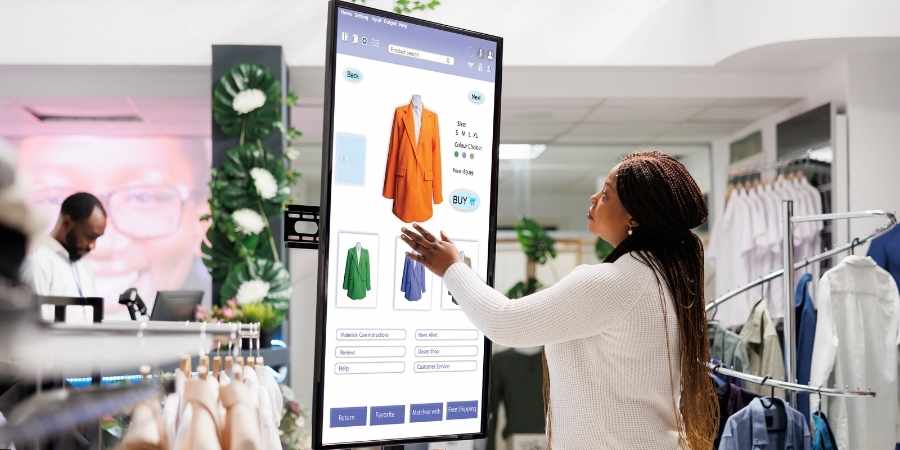Walk into any modern café, airport, or retail store in 2025, and you’ll likely be greeted not by a person but by a screen. These sleek, responsive, and quietly efficient digital touchpoints have redefined how businesses connect with customers. But not all screens are created equal.
Behind every tap, swipe, or scroll lies a carefully chosen kiosk screen that can either elevate the customer experience or quietly frustrate it.
In an era where attention spans are short and expectations are sky-high, the screen on your kiosk isn’t just hardware—it’s your brand’s personality, in pixels. From restaurant menus to healthcare check-ins, the type of screen you select says a lot about how seriously you take user experience.
So, what makes the ideal kiosk screen in 2025? Let’s explore how the right choice can transform interactions, perceptions, and ultimately, your bottom line.
Exploring the Use of Kiosk Screens
Most customers will interact primarily with your company through the kiosk screen. The quality and function of a screen used in a retail point, museum, or hotel always influences how satisfied the user will be. The correct kiosk screen can:
- Make User Experience Better: Allow for easy navigation and smooth use of touch.
- Boost Effectiveness: Improving how orders are placed, payments are made, and details are obtained.
- Reflect Brand Identity: Present the brand’s image using its designs, the setup of screens, and interactive features.
Factors You Should Consider When Choosing a Kiosk Screen
1. Touch Technology
Touch controls must be both prompt and accurate. Touch technologies are widely used in today’s kiosks.
- Capacitive Touch: Allows for enhanced sensitivity and suitable performance in indoor areas.
- Infrared Touch: This technology is strong and can be used in outdoor environments, as people do not need to touch the button physically.
- Surface Acoustic Wave (SAW): Results in clear and detailed images.
The decision on touch technology is influenced by the environment in which the kiosk will be used and who will use it.
2. Screen Size and Resolution
The screen size should align with the kiosk’s purpose:
- Small Screens (10″–15 “): Suitable for simple tasks like ticketing or check-ins.
- Medium Screens (15″–22 “): Ideal for menus, product browsing, or information displays.
- Large Screens (22″ and above): Best for interactive maps, directories, or promotional content.
High-resolution displays ensure crisp visuals, enhancing readability and user engagement.
3. Strength and Impact on the Planet
The monitors for kiosks in places with frequent visitors must be rugged enough to withstand many people and various weather conditions.
- Physical Strength: Will not easily scratch or break.
- Weather Conditions: The product should be waterproof and withstand all temperatures.
- Always On: Parts are designed to keep running day and night without overheating issues.
4. Accessibility Features
Everyone should feel included. Kiosk screens should address the needs of different users.
- Users with vision problems can benefit from Brightness and Contrast options.
- Screen Readers and Voice Commands are designed to help individuals who cannot see or use their hands.
- Multilingual Support: Providing services for users from all types of backgrounds.
5. Integration Capabilities
Kiosk screens nowadays should smoothly coordinate with other systems.
- Contactless and mobile wallets are two payment methods that Payment Gateways supports.
- In the background, this could mean integrating your inventory, CRM, or booking software.
- Peripheral gadgets: For example, printing, scanning, or photographing devices.
The Latest Developments in Kiosk Screen Technology
1) Customisation and Artificial Intelligence (AI)
AI-powered kiosks can evaluate user behaviour to provide tailored suggestions, improving customer satisfaction and boosting revenue. For example, a retail kiosk may provide product recommendations based on browsing or past purchases.
2) Touchless Communication
Following health concerns, touchless technologies are becoming more popular:
- Using gesture recognition, users can interact with interfaces without making physical contact.
- Voice commands: Making it easier to operate without using your hands.
- Integration of QR Codes: Allowing consumers to communicate with their smartphones.
3) Eco-friendly and Sustainable Designs
The design of kiosks is being influenced by environmental consciousness:
- Components that use less energy: lowering power usage.
- Recyclable materials reduce the influence on the environment.
- Modular designs increase the kiosk’s lifespan by making modifications and repairs simple.
4) Immersive Experiences with AR and VR
Augmented Reality and Virtual Reality are integrated to create engaging user experiences. For example, a clothing store kiosk might allow customers to try on outfits digitally, enhancing the shopping experience.
Real-World Applications
- Retail Sector
Retailers are leveraging kiosk screens to:
- Streamline Checkout Processes: Lower wait times and increase customer satisfaction.
- Enhance Product Discovery: Through interactive catalogs and personalised recommendations.
- Promote Loyalty Programs: Encourage repeat business.
2. Hospitality Industry
Hotels and restaurants utilise kiosks for:
- Self-Check-In/Out: Offering convenience to guests.
- Menu Browsing and Ordering: Enhancing dining experiences.
- Feedback Collection: Gathering customer insights for service improvement.
3. Healthcare Facilities
Medical institutions implement kiosks to:
- Facilitate Patient Registration: Streamlining administrative tasks.
- Provide Health Information: Educating patients on various topics.
- Schedule Appointments: Offering flexibility and reducing no-shows.
In conclusion
In 2025, choosing the ideal kiosk screen requires careful consideration of user experience, brand representation, and technology. By considering elements like touch technology, robustness, usability, and integration potential, companies may implement kiosks that satisfy operational requirements while also appealing to users. Adopting cutting-edge concepts like touchless interactions, AI personalisation, and sustainable designs can put your company at the forefront of innovation and guarantee that your kiosk screens effectively convey your beliefs and products.



